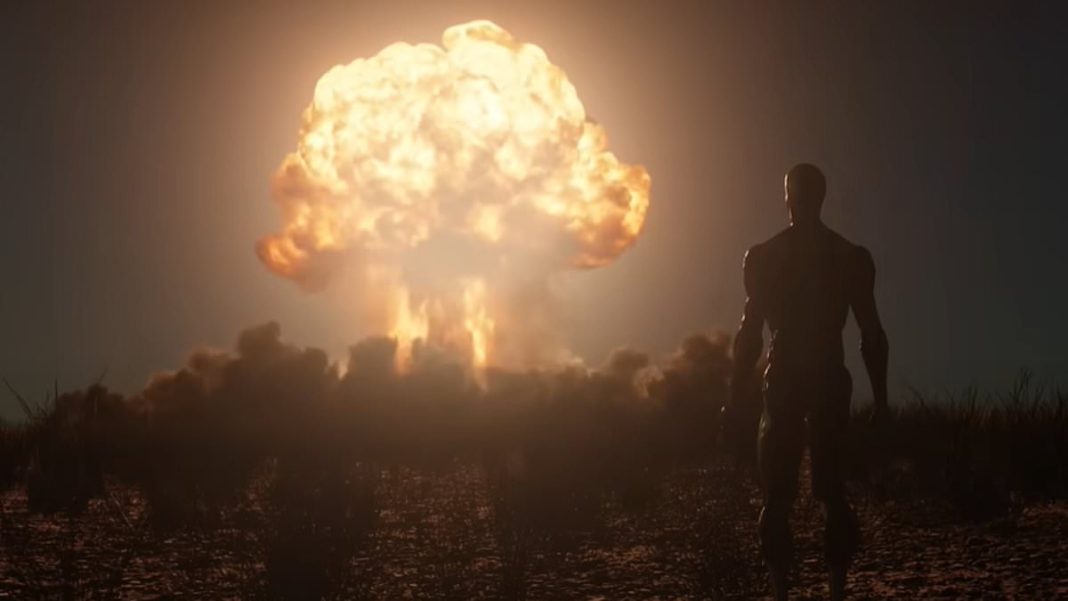Simulation reveals exactly what a nuclear bomb would do to your body,
As the world teeters on the brink of widespread conflict, a terrifying simulation has revealed what could happen to those caught in the blast of a detonating nuclear bomb.
Created by the appropriately named ‘atomic marvel’, the animation details the impact of an apocalyptic explosion in five distinct ‘zones’, each a certain distance from the blast site.
The clip—which has been viewed over 13million times—shows even those at the furthest reaches, two miles away, aren’t safe.
For those in zone one—for the purposes of the animation the outer range of the blast radius between 1.27km (0.8miles) and 3.27km (2miles)—the main risks are being rendered blind as retinas burn away from the intensity of the nuclear flash.
This flash would then be followed by a burst of radiation causing 2nd degree burns to scorch the flesh of the mannequin figure used in the animation.
Finally, the immense sound wave of the explosion may render those within its range temporarily or permanently deaf.
But those in zone one may be considered the lucky ones.
The fate of those in zone two—within 600m (2,000ft) and 1.27km (0.8miles)—the shockwave will be strong enough to instantly knock them off their feet.
This will leave them at risk of injury and concussion with ear drums rupturing from the pressure wave.
Their radiation burns will also be more severe third degree injuries covering a large extent of their body.
Things only get worse for those in zone three, between 350m (1150ft) and 600m (2,000ft).
Those this close to the nuclear detonation are hit by an 800km/h (500miles per hour) shockwave that hits one-and-a-half seconds after the blast.
This sends bodies flying like rag dolls into the distance, suffering injuries like catastrophic haemorrhages of blood and ruptured organs.
The lungs are particularly devastated by the shockwave the immense wave of pressure created by the atomic weapon, causing the organs to collapse.
Thermal radiation is worse this close to the blast and victims are left with 4th degree burns on much of their body.
Those in zone four are closest to what the video dubs the ‘fireball’—between 200m (650ft) and 350m (1150ft).
The grim animation shows that people in this zone are incinerated by a sudden increase in temperature a split second before their bodies are dismembered by the blast wave.
Those in zone five—effectively ground zero of the explosion—see the least suffering due to a rapid death.
Anyone closer than zone four’s 200m (650ft) is effectively vapourised immediately.
When a nuclear weapon detonates it creates a ball of air hotter than the sun’s 15,000,000C (59,000,000F) core.
Anything inside this radius is rendered into white hot plasma—effectively super-heated gas.
As one social media user grimly wrote: ‘This leaves us with a wise lesson: When a nuclear bomb explodes, it is best to be very far away or very close.’
The animation doesn’t capture the true horror of what a nuclear weapon being used in the modern era would mean.
Firstly, it takes place in an open plain, not the cities where nuclear weapons would most likely fall.
Those in any of the outer zones of the blast will also have to contend with a wave of flying shrapnel made of glass, concrete and metal from destroyed buildings and gutted skyscrapers.
Fires will spark throughout the area meaning any immediate survivors will also risk burning to death or suffocating from smoke inhalation.
What’s more, the measurements used in the animation to describe injuries that would occur are historic.
The figures refer to the blast radius of the ‘Trinity Test’—the first-ever detonation of a nuclear weapon which occurred in the New Mexico in 1945 famously carried out by American theoretical physicist J. Robert Oppenheimer.
That bomb had a strength of 18.6 kilotons—a measurement for nuclear weapons—with one kiloton equivalent to 1,000 tonnes of the explosive TNT.
Nuclear weapons of the modern age—which number over 12,000 and are capable of being launched across continents—are measured in the hundreds of kilotons.
This means the blast radius of any modern nuclear weapon will be of a far greater magnitude and devastation than that shown in the simulation.
For example, in a densely populated city like London, a 500kt blast could kill as many as 400,000 people in an instant. But more than 850,000 could also sustain injuries from the blast, shockwave and radiation.
With health infrastructure crippled in the wake of a blast many of these injured would succumb to their wounds in the following days.
The International Campaign to Abolish Nuclear Weapons notes that ‘all of the dedicated burn beds around the world would be insufficient to care for the survivors of a single nuclear bomb on any city’.
The animation also only covers the immediate horrors of a nuclear explosion and not those that will stalk any survivors in the days and years to come.
Lingering radiation spread by a nuclear explosion will poison the air, water and people many miles from initial blast for decades.
High or extended radiation exposure has a number of potential immediate and longer term health risks.
Exposure to radiation—which is impossible to see, smell or taste—damages tissues deep in the body, causing a condition called radiation sickness.
In the immediate aftermath, victims may suffer from nausea, vomiting, headache or diarrhoea.
Depending on the extent of exposure a patient can then recover or enter a tragic period of false hope.
At the higher levels a patient will strangely recover some days after the event before then becoming much sicker as their body shuts down their organs and cells damaged beyond any repair.
Such victims usually die withing a matter of weeks, even with medical care, from their body essentially ceasing to function or being unable to fight off any kind of infection.
In the longer term, exposure to radiation as well as food and water contaminated by radioactive material can increase the risk of developing cancers.
Rising global tensions have brought the prospect of a nuclear conflict back into the spotlight.
Putin’s invasion of Ukraine—and the UK’s support of the latter—saw Russian state TV brazenly simulated how Vladimir Putin could launch a nuclear strike on London, declaring there would be ‘no survivors’.
And just this week US and Israeli warplanes have battered nuclear facilities in Iran in a bid halt the country’s development of an atomic bomb.
Surviving a nuclear explosion is largely up to chance depending on where a person is at the time of the explosion.
However, the British Government has issued advice for what the public should do in the event of a ‘radiation emergency’.
The primary advice is to get indoors as soon as possible, with health chiefs stating this can reduce exposure to radiation by 85 per cent compared with being outdoors.
Being indoors also reduces the amount of radioactive material inhaled by 40 per cent, the advice reads.
While some buildings are better than others, getting indoors in any way possible should be the priority, according to health chiefs.
‘Buildings made of brick, stone, concrete or similar materials provide the best protection, but being inside any building is better than being outside,’ it states.
‘If you are already inside a building, stay there.’
It warns that Britons may be advised to stay indoors for up to two days—a procedure called ‘sheltering-in-place’—to reduce further potential exposure.
People who were outside and nearby the side of the emergency would be at risk of their clothes, skin and hair being contaminated.
As a result, they may be advised to self-decontaminate, which involves taking off clothing—which removes 90 per cent of any contamination—and showering.







